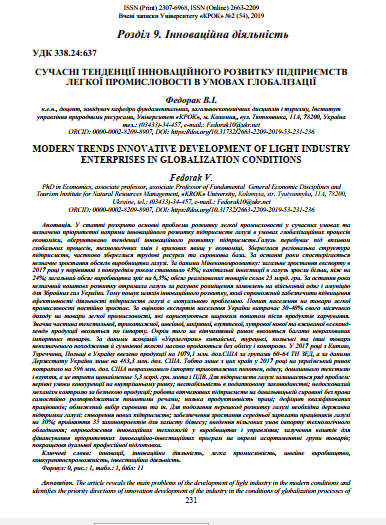MODERN TRENDS INNOVATIVE DEVELOPMENT OF LIGHT INDUSTRY ENTERPRISES IN GLOBALIZATION CONDITIONS
DOI:
https://doi.org/10.31732/2663-2209-2019-53-231-236Keywords:
innovations, innovative activity, light industry, sewing production, competitiveness, investment activityAbstract
The article reveals the main problems of the development of light industry in the modern conditions and identifies the priority directions of innovation development of the industry in the conditions of globalization processes of the economy, the tendencies of innovation development of enterprises are grounded. The industry is under the influence of global processes, technological changes and crisis phenomena in the economy. The regional structure of enterprises has survived, the labor resources and the raw material base have been partially preserved. In recent years there has been a slight increase in the volume of industry production. According to the Ministry of Economic Development and Trade: the total export growth in 2017 compared to the previous year was 43%; capital investment in the industry grew by more than 24%; total production increased by 6.3%; the volume of goods sold amounted to 23 billion game. Over the past few years, the industry has received insignificant impetus for the development of orders for military clothing and ammunition for the Armed Forces of Ukraine. Therefore, the search for ways of innovation development, which is capable of ensuring the improvement of the efficiency of enterprises in the industry, is a topical issue. Demand for light industry goods is constantly increasing. According to the experts of the Ukrainian population, he spends 30-40% of his monthly income on light industry goods, which are in high demand after food. Much of the textile, knitwear, garment, leather, footwear, fur new and used "second-hand" products are imported for import. In addition, many imported goods are not imported into the domestic market. According to the association "Ukrlegprom", Chinese, Turkish, Polish and other products of undetermined origin and dubious quality are massively sold without consideration and control. In 2017, imports from China, Turkey, Poland to Ukraine totaled $ 1079.1 million in groups 60-64 tons of foreign trade, and according to the State Statistics Service of Ukraine, only $ 483.3 million. USA. That is, only from these countries in 2017 the Ukrainian market fell by 596 million dollars. US untapped imports of knitted fabrics, clothing, home textiles and footwear, and this is a loss of at least 5.3 billion UAH. duties and VAT. There are a number of problems for the industry: unequal competition in the domestic market; instability in tax legislation; imperfect control mechanism for product safety; the work of domestic enterprises on the customer's raw materials without the right to dispose of sewed things by themselves; low labor productivity; shortage of skilled workers; limited selection of raw materials, etc.To overcome obstacles to the development of the industry, state support of the industry is needed: creation of new enterprises; to provide an increase in the average salary of industry workers by 30%; adoption of 35 bills for business protection; introduction of preferential conditions for import of technological equipment; introduction of innovative technologies into production and management; attraction of funds for financing of priority innovation and investment programs for separate assortment groups of goods; improvement of dual professional training.
Downloads
References
Легка промисловість: реалії та перспективи. Електронне консультаційне видання УТЕКА. URL : http://www. ilikenews.com.ua/
Вернер І. О. Україна у цифрах у 2017 році. І.О. Вернер та ін.; Держ. сл. статистики. Київ : ТОВ Консультант, 2018. 241с.
Ізовіт Т.Л. В якому стані український Легпром увійшов у 2015 рік. URL : http://fru.org.ua/ua/mediacenter / blogs / izovit / viakomu.
Офіційний сайт Державного комітету статистики України. URL : http://www. ukrstat. gov. ua/.
Офіційний сайт Асоціації «Укрлегпром» URL : http://ukrlegprom.org.ua/statistika analitika ukrlegpromu.html.
Грищенко І. М., Ізовіт В. А. та ін. Легка промисловість України: реалії та перспективи [експертно-аналітична доповідь]. Київ : КНУТД, 2015. 82 с.
Денисенко М. П. Основні положення формування інвестиційно-інноваційної діяльності підприємства. Інвестиції практика та досвід, № 22, 2016. С. 17-20.
Карюк В. І. Вплив інноваційного потенціалу на соціально-економічний розвиток підприємства. Ефективна економіка. 2016. № 10. URL : http://www.economy.nayka.com.ua
Паливода О. М., Прима Ю. І. Формування економічної стійкості швейних підприємств України на основі кластерних мереж. URL : http://knutd.com.ua/ourpublikation.
Маргасова В. Г., Сіренко К. Ю. Державне регулювання інноваційного розвитку легкої промисловості в умовах трансформаційних змін в економіці України. Бізнесінформ. 2013. № 5. С. 54-60.
Сіренко К. Ю. Передумови впровадження інноваційної моделі розвитку легкої промисловості в Україні. Актуальні проблеми імплементації інноваційно-орієнтованої моделі розвитку національної економіки» : збірник матеріалів роботи круглого столу 05.04.2012 р. Чернігів : ЧДІЕУ. 2012. С. 58-60.


